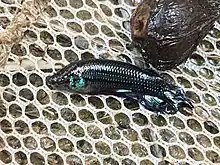Peaceful betta
The peaceful betta or crescent betta (Betta imbellis) is a species of gourami native to Southeast Asia.
| Peaceful betta | |
|---|---|
_20100512_2.jpg.webp) | |
| Scientific classification | |
| Domain: | Eukaryota |
| Kingdom: | Animalia |
| Phylum: | Chordata |
| Class: | Actinopterygii |
| Order: | Anabantiformes |
| Family: | Osphronemidae |
| Genus: | Betta |
| Species: | B. imbellis |
| Binomial name | |
| Betta imbellis Ladiges, 1975 | |
Betta imbellis has a pair of suprabranchial chambers that each house an air‐breathing organ known as the labyrinth organ, a complex bony structure lined with thin, highly vascularised respiratory epithelium. The labyrinth organ is a morpho‐physiological adaptation that allows the B. imbellis to extract oxygen from air. This adaptation allows the species to persist in extreme conditions.[2]
Despite being called peaceful betta, males of the species may fight each other especially when in breeding condition.[3]
Description
Betta imbellis grows to a maximum standard length of 6 cm (2.4 in).[4]
Distribution
Betta imbellis occurs naturally in Southern Thailand, Malaysia, and Indonesia, although it has been introduced to Singapore.[5]
Habitat
Betta imbellis lives in sluggish bodies of water, including rice paddies, swamps, streams and ponds, with a substrate composed of leaf litter and mud.[6]
Conservation status
Betta imbellis is listed as least concern by the IUCN Red List. It is still threatened by pollution and hybridization with released domesticated bettas (Siamese fighting fish) and other bettas in the B. splendens complex.[1]

Diet
In the wild, Betta imbellis feeds on terrestrial and aquatic invertebrates. In captivity, the species is fed live or frozen food like Daphnia, Artemia or bloodworms.[7]
Breeding
The more colorful bodies of the males distinguishes them from the females, the males having blue hues in their brownish bodies.[3] Male and female individuals of Betta imbellis can live together outside breeding season, as well as getting together for breeding. Males will build a bubble nest before breeding. After mating the male catches the falling eggs and places them in his bubble nest. In 1–2 days the eggs hatch and continue absorb their yolk sack for 2 days. After that the fry become free swimming. Until this the male cares for them.[8]
Human use
Betta imbellis is found in the aquarium trade.[9]
References
- Low, B.W. (2019). "Betta imbellis". IUCN Red List of Threatened Species. 2019: e.T181333A89804943. doi:10.2305/IUCN.UK.2019-2.RLTS.T181333A89804943.en. Retrieved 20 November 2021.
- Tate, M.; McGoran, R. E.; White, C. R.; Portugal, S. J. (September 2017). "Life in a bubble: the role of the labyrinth organ in determining territory, mating and aggressive behaviours in anabantoids: the labyrinth organ and the anabantoids". Journal of Fish Biology. 91 (3): 723–749. doi:10.1111/jfb.13357. PMID 28868750.
- Alderton, David (2019). Encyclopedia of Aquarium and Pond Fish. UK: Dorling Kindersley Limited. p. 103. ISBN 978-0-2413-6424-6.
- Froese, Rainer; Pauly, Daniel (eds.) (2014). "Betta imbellis" in FishBase. February 2014 version.
- "Betta imbellis, Crescent betta : Aquarium".
- "A Guide to Keeping Betta imbellis". June 2020.
- "Betta imbellis – Crescent Betta — Seriously Fish".
- "Betta Imbellis (Crescent or Peaceful Betta) Fish Care Guide". 19 July 2020.
- "Betta imbellis, Crescent betta : Aquarium".
